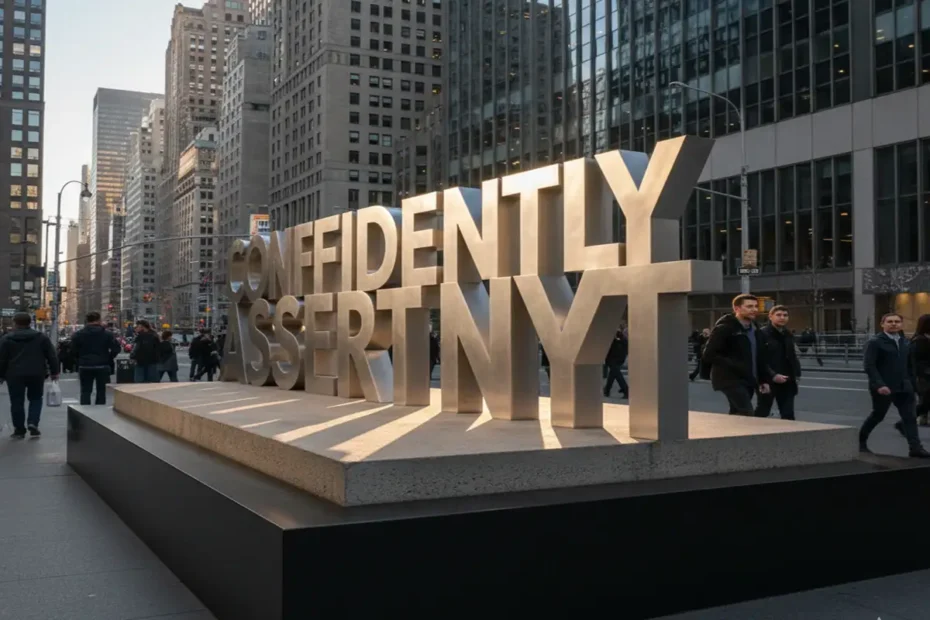Crossword puzzles have long been a favorite pastime for millions of word lovers, and The New York Times Crossword stands at the very top of that list. Every day, solvers encounter clues that are clever, nuanced, and sometimes intentionally cryptic. One such clue many people search for is “confidently assert NYT.” Because crossword clues can carry layered meanings, understanding this phrase helps solvers improve both their vocabulary and puzzle-solving skills. In this article, we break down what this clue typically refers to, how it fits into crossword logic, and why so many users come across it while trying to improve their crossword abilities.
What Does “Confidently Assert NYT” Usually Mean?
The clue “confidently assert NYT” most often points to answers related to speaking with certainty or making a strong claim. In crossword language, this can be represented by short, punchy verbs such as “aver,” “avow,” or “assert.” These words capture the idea of speaking with firm conviction, exactly what the clue suggests.
Crossword constructors often choose compact words with strong meanings because they fit neatly into grids while providing a clever mental challenge. The New York Times Crossword is known for using higher-level vocabulary, making clues like this both educational and intellectually engaging.
Why NYT Crossword Clues Can Be Tricky
Understanding the clue “confidently assert NYT” becomes easier when you recognize how NYT crosswords are designed. Their style tends to lean into subtlety, wordplay, and multiple potential interpretations. The editors aim to craft clues that are not only accurate but also encourage deeper thinking. That means even simple words may be clued in unexpected ways.
For example, “confidently assert” could logically lead to several answers, but the puzzle’s structure, letter count, and crossings determine the exact solution. This is why solvers often search for explanations online: the clue is short, but the meaning requires thoughtful interpretation.
Improving Your Skills Through Clue Analysis
One of the best ways to grow as a crossword solver is to analyze recurring clue patterns. The clue “confidently assert NYT” is a perfect example of a style you’ll encounter repeatedly. The phrasing centers around communication, attitude, and certainty categories that appear frequently across crossword puzzles.
Words like AVOW, AVER, and ALLEGE are not just vocabulary items; they are part of a solver’s toolkit. When you learn what types of clues tend to point toward these words, you become more confident and efficient in your solving process. Over time, recognizing the structure behind clues like “confidently assert NYT” can dramatically improve your accuracy and speed.
The Role of Context in Understanding Crossword Clues
Crosswords don’t exist in isolation. Their clues often rely on context, sometimes grammatical, sometimes cultural. When approaching the clue “confidently assert NYT,” solvers must consider:
-
Tone and phrasing
Words like “confidently” imply certainty and directness. -
Common crossword vocabulary
Certain verbs are favorites among constructors because they fit multiple grids. -
Letter patterns
Crossings from other answers narrow down possibilities.
When all these elements come together, a solver can more easily determine the correct word. This is why analyzing frequently searched clues provides such a valuable learning experience.
Why This Clue Trends Among Crossword Fans
The clue “confidently assert NYT” trends online because it’s both common and slightly ambiguous. Puzzle enthusiasts often look it up after getting stuck, not because the answer is obscure but because NYT crosswords challenge solvers to think differently.
Additionally, this clue offers a great opportunity to expand vocabulary. Words like “aver” are seldom used in everyday speech, yet they appear regularly in puzzles. This gap between daily language and crossword language is exactly what makes the solving process fun and intellectually stimulating.
Tips for Solving Similar NYT Crossword Clues
If you want to get better at solving clues structured like “confidently assert NYT,” here are a few helpful strategies:
-
Learn common crossword verbs
Words like aver, avow, cite, allege, and claim often appear. -
Pay attention to clue length
The number of letters significantly narrows your choices. -
Use crossings wisely
Even one or two letters from intersecting answers can reveal the solution. -
Practice frequently
The more puzzles you solve, the faster you’ll recognize patterns. -
Build a crossword-specific vocabulary list
Many expert solvers maintain personal lists of commonly clued words.
Final Thoughts
The phrase “confidently assert NYT” represents more than just a crossword clue; it reflects the elegance and complexity of The New York Times Crossword itself. Whether you’re a seasoned solver or just starting, understanding clues like this helps you become a more confident and successful puzzle enthusiast. With practice, patience, and pattern recognition, you’ll find yourself navigating even the trickiest crossword clues with ease.
FAQs:
1: What does the clue “confidently assert NYT” mean?
The clue “confidently assert NYT” typically refers to a verb meaning to state something with certainty, such as AVER or AVOW, which are common answers in NYT crosswords.
Why does the NYT Crossword use clues like “confidently assert”?
The New York Times Crossword often uses concise, sophisticated wording to challenge solvers. Clues like “confidently assert” encourage the use of higher-level vocabulary.
What is the most common answer for “confidently assert NYT”?
The most common answer is AVER, a four-letter verb frequently used in crossword puzzles due to its clarity and grid-friendly length.
How can I get better at solving clues like “confidently assert NYT”?
Practice frequently, learn common crossword verbs, and rely on crossing letters. Over time, clues like this become easier to recognize.
Why do people search for “confidently assert NYT” online?
Many solvers look it up when they get stuck or want confirmation of an answer. It’s a common clue with multiple possible solutions depending on puzzle length.
